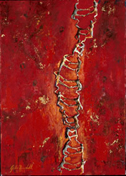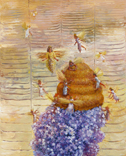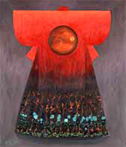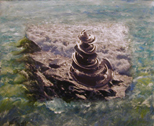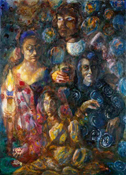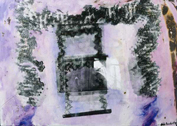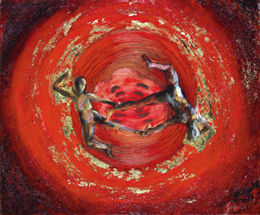
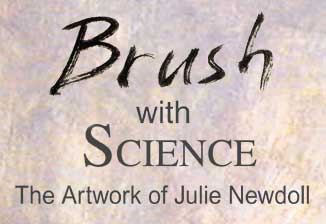
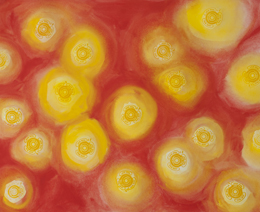
...Julie Newdoll merges life science and culture, myths and molecules in her
paintings, music, journal covers and science games.
Shakespeare:
A Mirror up to Science
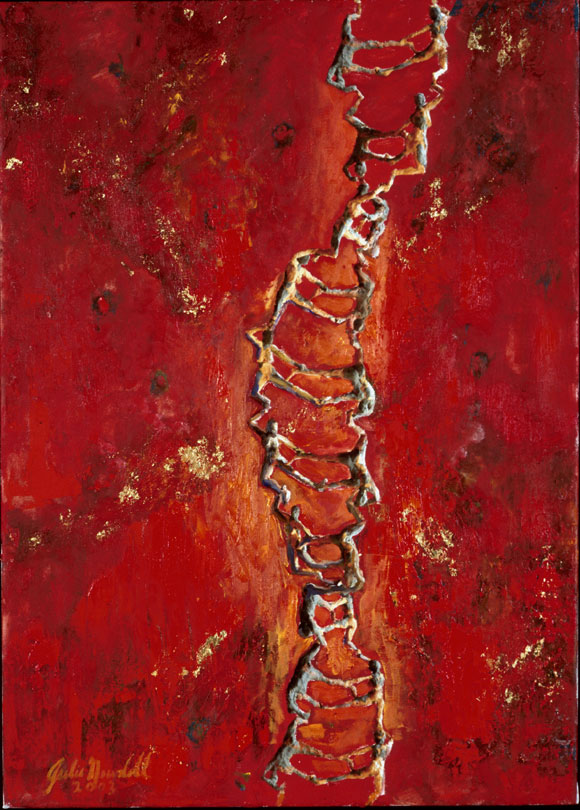
This painting uses figures to represent the structure of DNA, our genetic material which holds the information for what we look like and how we work. DNA is a double helix, where one strand is oriented in one direction and the other strand points in the opposite direction. Notice that on one side of the ladder of figures all the heads are looking upward, and on the other side their heads are all pointing downward. The male-female tension between the scientists involved in the discovery of the structure of DNA is another element to this work. This painting was completed in 2003, the year we celebrated the 50th anniversary of solving the structure of DNA. The human interactions in the painting symbolizes the ever changing give and take between the two strands of the helical structure and the molecules from which they are formed. The delicate bonds between some elements of the structure and strong bonds between others, their balance and cooperation, invokes a kind of
dance of the molecules.
Inspired in part by the book, “Rosalind Franklin: Dark Lady of DNA” by Brenda Maddox, Harper Collins Publishers, 2002.
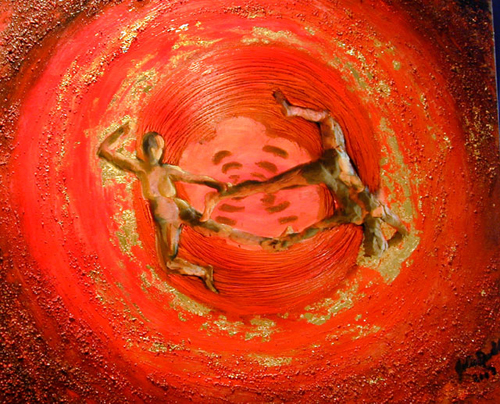
The dance and the tension between residues, people, male and female. Rosalind Franklin's famous X-ray diffraction photograph of DNA commands the center of the image.
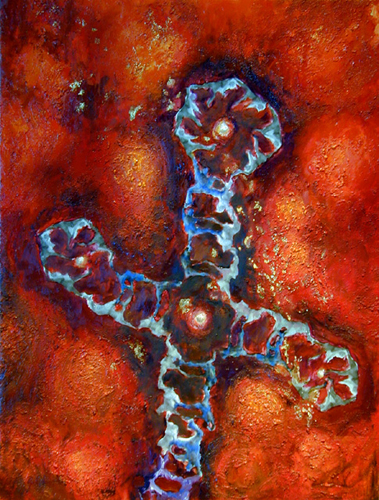
RNA as the new Dogma, 23" x 33" ,2003. Sold to private collector. Prints available $450.
Human figures are assembled here into a possible RNA shape. DNA is often thought of as our primary life giving molecule. We may have evolved from RNA in a form that was capable of self replication. Scientists are still discovering more that RNA is responsible for in our cells. Although the bases that make up RNA are very similar to DNA, they can create structures very different from the double helix that we know DNA to typically, but not always, form.
RNA does much more than previously thought, according to John Mattick of the University of Queensland. His research and that of his collaborators may overturn the Central Dogma, the current thinking on how we control and express our genes, in which RNA plays mainly a messenger role. RNA may do much, much more. This is a topic for a new painting series to come.
The figures here are more ancient and ambiguous than those in "Dawn of the Double Helix". Surrounded by forces without and within, these figures collect around pearl-like ions, and brush against metallic flakes of gold. Surfaces such as iron pyrite (fool's gold) may have served as substrates for the first self replicating molecules to form upon.

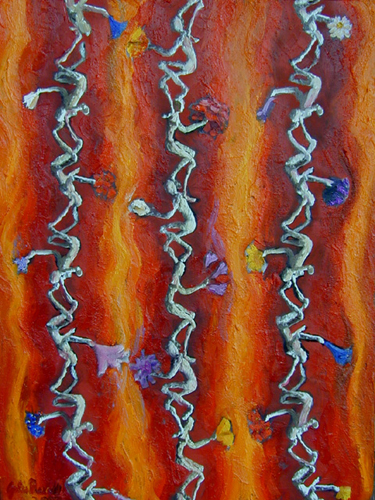
On the left, human figures arranged in a beta sheet, a structure found in folded proteins. The flowers are like the sidechains each amino acid holds out. Human figures arranged in an alpha helical arrangement on the right.
Inspired by the beta sheet structure found in proteins, discovered by Linus Pauling and Robert Corey, and Herman Branson.

Shiva is the dancing manifestation of the Hindu god Nataraja. The dance of Shiva represents a delicate balance of creation and destruction, preservation and evolution, a life force as well as death. Here Shiva is dancing inside of a telomere loop, acting as the enzyme telomerase. The telomere is like the shoelace cap on the ends of a chromosome, keeping the lace (chromosome) from unraveling. Each time a human cell divides, all the chromosomes must also divide. The telomere gets shorter when the cell divides, and the protein “telomerase” inside the telomere binding complex lengthens the telomere again. Telomerase also stabilizes the telomere. The telomere has now been shown to be a large loop called a telomere loop next to a smaller loop, the D-loop.
Telomerase was once thought to be a potential key to the fountain of youth. If it were introduced into older people that no longer make telomerase in their cells, would their cells go on dividing? Cancer cells, on the other hand, have plenty of telomerase to perpetuate their eternally dividing cells. This is still a point of controversy, but it is certain that telomerase is an important enzyme, and one that is being studied carefully.
Inspired in part by the paper "Mammalian telomeres end in a large duplex loop." Griffith JD, Comeau L, Rosenfield S, Stansel RM, Bianchi A, Moss H, de Lange T. , Cell 1999 May 14;97(4):503-14. Information on Shiva from "Nataraja in Art, Thought and Literature" by C. Sivaramamurti, Thomas. Published in Nature Reviews Genetics 4, 845 (2003).
Programmed
Cell Death:
Apoptosis

